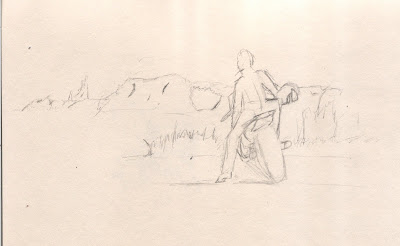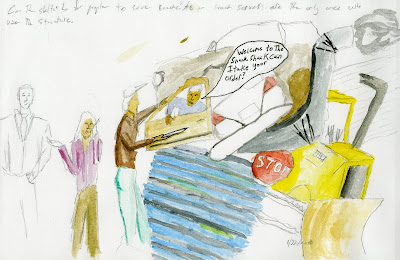To make my introduction as a T.A. for Suzanne's drawing class I wanted to do something to symbolize the experimental learning characterized by this semester as well as a new drawing style for myself to experiment with.
To start off with I envisioned a guy on a motorcycle looking out to the sunset. I looked up some images of motorcycles to reference. This is always important for me because although it seems like we can just draw what we imagine in our head it's always frustrating once it comes down to really drawing it with all the parts coming together right. I did a quick sketch of a motorcycle to get aquatinted with its form. I've never been around many motorcycles so this quick sketch helped me understand the main points of interest that define the form: The protruding handlebars, the lowered seat, the raised tail fin like rear and the fat back tire.
I then sketched out what I imagined the composition would look like. The first thing I drew was the rear "tail" of the motorcycle since that overlaps all other elements (especially since the motorcycle is foreshortened). These few simple lines indicating the tail are also at an angle since everything will be leaning. Next I drew the man's left leg. The leaning sense of the rear motorcycle tail dictates what position the man's leg will be in, which then dictates the rest of the man. For the background mesas and mid-ground grass I looked up desert photos. Since this composition would be about shadows and bits of color defining the forms, I didn't worry about details too much.

Since this was something new for me I printed out a copy of this pencil drawing to test the style that would characterize its final form. I used a micron and a sharpie to begin making the bold shade on the motorcycle. I left key elements blank to give a "gleaming" effect. To begin building the man over the pencil drawing I once again looked at reference photos of people sitting on motorcycles (all clad in leather) focusing on the wrinkles in their clothing.
To make the sunset I broke out the watercolors mixing some orange and yellow concentrating the color near the top of the mesas and then fanning it out.
With the final composition (below) I copied most of what I did in the test version. I did some simple photoshop stuff to make the whites whiter and the blacks blacker. The main difference is that the pencil lines are erased so that the dramatic black shadows are all that define the forms.



 When visitors enter the Gatewood lobby they will be brought into the context of a grouping of shelters complemented by a community of students. We as presenters will speak about how the spaces are used and maintained. How interiority can be implied as in experiencing the interior from the exterior. We will share the types of scenarios these shelters are part of though our illustrated visions. Knowledge of simplicity and limiting one's self shall be passed on. Illustrations and photos complemented by our own stories will tell of the experiences in challenging design as well as the importance of building a structure as a group forming bonds.
When visitors enter the Gatewood lobby they will be brought into the context of a grouping of shelters complemented by a community of students. We as presenters will speak about how the spaces are used and maintained. How interiority can be implied as in experiencing the interior from the exterior. We will share the types of scenarios these shelters are part of though our illustrated visions. Knowledge of simplicity and limiting one's self shall be passed on. Illustrations and photos complemented by our own stories will tell of the experiences in challenging design as well as the importance of building a structure as a group forming bonds.
 I loved Clarissa Anderson's Fliers where she has black images against the green background. I decided to do something similar. I thought about important symbols first and then about how aid is actually getting to Haiti. Hands reaching up for dropping aid along with the recognizable silhouettes of helicopters makes a powerful statement.
I loved Clarissa Anderson's Fliers where she has black images against the green background. I decided to do something similar. I thought about important symbols first and then about how aid is actually getting to Haiti. Hands reaching up for dropping aid along with the recognizable silhouettes of helicopters makes a powerful statement.








